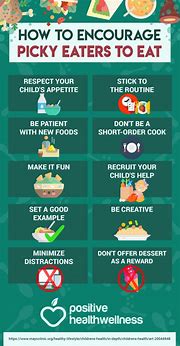How To Encourage Picky Eaters To Try New Foods Without A Struggle
It’s common for parents and caregivers to face challenges when introducing new foods to their children. Picky eating can be a source of stress and frustration, but it’s important to remember that it’s a normal part of child development. With patience and a bit of creativity, you can help your picky eater expand their palates and develop a healthy relationship with food.
Understanding Picky Eating: Unveiling the Reasons Behind Food Aversions
Picky eating is often a result of a combination of factors, including:
- Sensory Sensitivities: Some children are more sensitive to textures, smells, and tastes than others. They may find certain foods overwhelming or unpleasant.
- Fear of the Unknown: Children can be hesitant to try new foods, especially if they’ve had a negative experience with them in the past.
- Control and Independence: Picky eating can sometimes be a way for children to assert their independence and control over their environment.
- Lack of Exposure: If children are only exposed to a limited number of foods, they may be less likely to try something new.
It’s essential to understand the reasons behind your child’s picky eating to address them effectively.
Creating a Positive Food Environment: Setting the Stage for Exploration
The environment in which you present food plays a crucial role in encouraging acceptance. Here are some tips for creating a positive food environment:
- Make mealtimes enjoyable: Avoid distractions like screens or television during meals. Instead, focus on conversation, interaction, and enjoying the company of others.
- Create a relaxed and stress-free atmosphere: If your child feels pressured or anxious during mealtimes, they are less likely to try new foods.
- Avoid forcing or bribing: This can create negative associations with food and lead to power struggles.
- Let your child explore and play with food: Allow them to touch, smell, and even taste different foods in their own time.
The Power of Presentation: Making Meals Appealing to Young Eyes
Presentation plays a vital role in attracting children’s attention and sparking their interest in trying new foods.
- Make food fun and colorful: Use fun shapes, colors, and decorations to make meals visually appealing.
- Engage different senses: Incorporate textures, smells, and sounds into mealtimes to make them more engaging.
- Serve food in creative ways: Use different serving dishes or try creating fun characters out of food.
Introducing New Foods Gradually: Building Confidence, One Bite at a Time
Introducing new foods gradually and patiently is key to helping children develop a liking for them.
- Start with familiar foods: Introduce new foods alongside foods that your child already enjoys.
- Offer small portions: Start with small bites to avoid overwhelming your child.
- Be patient: It may take multiple exposures for a child to accept a new food.
- Don’t give up: Keep offering the new food in different ways and at different times.
Involving Kids in the Kitchen: Empowering Choice and Ownership
Get your kids involved in the kitchen to foster a sense of ownership and excitement about food.
- Let them choose ingredients: Allow them to help select fruits, vegetables, or other ingredients for meals.
- Give them age-appropriate tasks: Let them assist with simple tasks like washing vegetables, mixing ingredients, or stirring.
- Cook together: Prepare meals as a family, making it a fun and interactive experience.
Making Mealtimes Fun and Engaging: Turning Food into an Adventure
Make mealtimes fun and interactive to encourage your child’s curiosity and excitement about food.
- Turn mealtime into a game: Use games or activities to make mealtimes more engaging.
- Tell stories about food: Share stories about where food comes from or how it’s grown.
- Create a “food adventure” theme: Transform mealtimes into a food adventure, exploring different cultures and cuisines.
The Importance of Consistency: Building Healthy Habits Through Routine
Consistency is crucial for building healthy habits, especially when it comes to food.
- Stick to a regular mealtime schedule: This helps establish a routine and make mealtimes predictable.
- Offer a variety of healthy foods: Ensure that your child is exposed to a wide range of nutritious options.
- Avoid giving in to demands for unhealthy foods: While it’s fine to indulge occasionally, it’s essential to avoid giving in to demands for unhealthy foods.
Handling Refusal with Patience: Avoiding Power Struggles at the Table
Refusal is a normal part of the process, and it’s important to handle it with patience and understanding.
- Avoid forcing or bribing: This can backfire and create negative associations with food.
- Stay calm and patient: Respond to refusal with empathy and understanding.
- Offer alternatives: If your child refuses a particular food, offer them a different healthy option.
- Don’t make a big deal out of it: Avoid making mealtimes a battleground.
Role Modeling Healthy Eating: Leading by Example for Long-Term Success
Children learn by observing others, so it’s essential to role model healthy eating habits.
- Eat a variety of healthy foods: Show your child that you enjoy eating a wide range of foods.
- Make healthy choices: Make healthy choices when grocery shopping, cooking, and eating out.
- Talk about the benefits of healthy eating: Explain to your child why it’s important to eat healthy foods.
Seeking Professional Help: When to Consult a Nutritionist or Pediatrician
If you’re concerned about your child’s picky eating, it’s always a good idea to consult with a healthcare professional.
- A nutritionist: A nutritionist can provide guidance on creating a balanced diet for your child and address any specific nutritional concerns.
- A pediatrician: A pediatrician can rule out any underlying medical conditions that may be contributing to picky eating.
Conclusion
Encouraging picky eaters to try new foods takes time, patience, and a positive approach. By understanding their needs, creating a supportive environment, and introducing foods gradually, you can help them develop a healthy relationship with food. Remember to be patient, consistent, and celebrate small victories along the way!
FAQ
Q: What if my child refuses to try any new foods?
A: It’s important to be patient and persistent. Keep offering the new food in different ways and at different times. Avoid pressuring or forcing them to eat it, as this can backfire.
Q: How can I make mealtimes more fun for picky eaters?
A: There are many creative ways to make mealtimes more engaging for picky eaters. You can use fun shapes, colors, and decorations, involve them in the cooking process, and create a “food adventure” theme.
Q: What are some common mistakes parents make when dealing with picky eaters?
A: Some common mistakes include forcing or bribing children to eat, making a big deal out of refusal, and giving in to demands for unhealthy foods.
Q: When should I seek professional help for picky eating?
A: If you’re concerned about your child’s picky eating, it’s always a good idea to consult with a healthcare professional. This is especially important if the picky eating is severe or if it’s affecting their growth and development.

